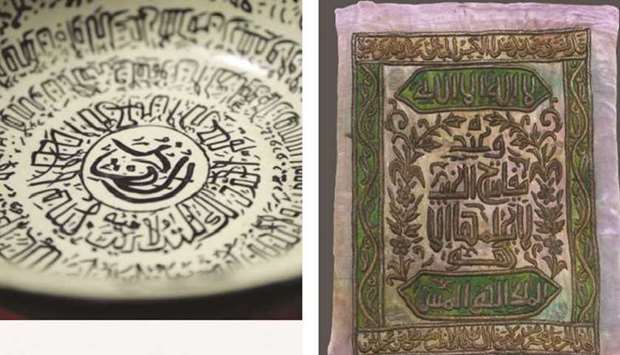Qatar Museums (QM) is highlighting an array of exhibitions and collections at galleries and museums, in addition to public art, to mark World Calligraphy Day this year.
“World Calligraphy Day brings together calligraphy enthusiasts to celebrate the art of penmanship. It offers an opportunity to discuss, practice, and learn this beautiful art form,” the QM said in an e-mail to Culture Pass members on Wednesday.
The event, founded by Manuscript Pen Company in 2017, brings together “experts and novice across the globe to discuss, practice, learn and celebrate the art of calligraphy and creative lettering” on August 11 annually.
In the face of the coronavirus (Covid-19) pandemic, this year’s campaign focused on spreading additional positivity and goodwill by encouraging people to “write their favourite positive word, take photos of their handwritten creations, and post it to their social media channels”.
Meanwhile, the annual Mal Lawal exhibition, taking place at the National Museum of Qatar (NMoQ), features a diverse range of objects, including a collection of Islamic manuscripts by Qatari engineer and collector Ibrahim al-Fakhro.
He is described as “a passionate collector deeply interested in showcasing the development and progression of calligraphy within the Islamic world”, whose compiled items span more than 1,400 years.
Visitors meanwhile have the opportunity to take part in a 3D virtual tour at the Museum of Islamic Art and view rare collections and items, such as a bowl made in Basra (in today’s Iraq) with inscriptions of “earliest modes of Arabic calligraphy”, such as Kufic scripts.
This old city is known to be a leading centre of fine pottery in the Abbasid Caliphate (750-1258 CE).
A wide range of collections that “demonstrate the finesse of Arabic calligraphy” also fascinate visitors at the Faisal Bin Qassim Museum, including a ceramic bowl from the 18th century in Kashmir.
Motorists who often roam around the city will also notice several public art, especially the murals at Salwa road created by renowned French-Tunisian artist, eL Seed.
“Big, bold and unmissable, eL Seed’s Calligraffiti presents a fresh take on a traditional art form,” the QM said. “The murals are anchored in our culture, each inspired by an aspect of life in Qatar.”
“In our continued efforts to promote creativity from within and take art out onto the streets, we asked Calligraffiti artist, eL Seed, to decorate the Salwa Road with 52 large-scale murals,” the QM added.
The QM also put a spotlight on a 7.5m-high stainless steel sculpture by British calligraphy artist Sabah Arbilli, which stands at a prominent area on the Doha Corniche.
Arbilli drew inspiration in creating this piece “based on a poem by HE Sheikh Jassim bin Mohamed al-Thani, the founder of Qatar”.
Qatar-based artist Fatima al-Sharshani is highlighting “the beauty of Arabic calligraphy alongside the beauty of shapes and lines”, with her public art installation at the Post Office park.
“Some say that calligraphy is the engineering of the soul excited by your hands. To many, calligraphy is just a subject, mastering different fonts … but it is more than that, it is a form of art that utilises the beauty of language,” she said.
The event, founded by Manuscript Pen Company in 2017, brings together “experts and novice across the globe to discuss, practice, learn and celebrate the art of calligraphy and creative lettering” on August 11 annually.
In the face of the coronavirus (Covid-19) pandemic, this year’s campaign focused on spreading additional positivity and goodwill by encouraging people to “write their favourite positive word, take photos of their handwritten creations, and post it to their social media channels”.
Meanwhile, the annual Mal Lawal exhibition, taking place at the National Museum of Qatar (NMoQ), features a diverse range of objects, including a collection of Islamic manuscripts by Qatari engineer and collector Ibrahim al-Fakhro.
He is described as “a passionate collector deeply interested in showcasing the development and progression of calligraphy within the Islamic world”, whose compiled items span more than 1,400 years.
Visitors meanwhile have the opportunity to take part in a 3D virtual tour at the Museum of Islamic Art and view rare collections and items, such as a bowl made in Basra (in today’s Iraq) with inscriptions of “earliest modes of Arabic calligraphy”, such as Kufic scripts.
This old city is known to be a leading centre of fine pottery in the Abbasid Caliphate (750-1258 CE).
A wide range of collections that “demonstrate the finesse of Arabic calligraphy” also fascinate visitors at the Faisal Bin Qassim Museum, including a ceramic bowl from the 18th century in Kashmir.
Motorists who often roam around the city will also notice several public art, especially the murals at Salwa road created by renowned French-Tunisian artist, eL Seed.
“Big, bold and unmissable, eL Seed’s Calligraffiti presents a fresh take on a traditional art form,” the QM said. “The murals are anchored in our culture, each inspired by an aspect of life in Qatar.”
“In our continued efforts to promote creativity from within and take art out onto the streets, we asked Calligraffiti artist, eL Seed, to decorate the Salwa Road with 52 large-scale murals,” the QM added.
The QM also put a spotlight on a 7.5m-high stainless steel sculpture by British calligraphy artist Sabah Arbilli, which stands at a prominent area on the Doha Corniche.
Arbilli drew inspiration in creating this piece “based on a poem by HE Sheikh Jassim bin Mohamed al-Thani, the founder of Qatar”.
Qatar-based artist Fatima al-Sharshani is highlighting “the beauty of Arabic calligraphy alongside the beauty of shapes and lines”, with her public art installation at the Post Office park.
“Some say that calligraphy is the engineering of the soul excited by your hands. To many, calligraphy is just a subject, mastering different fonts … but it is more than that, it is a form of art that utilises the beauty of language,” she said.




